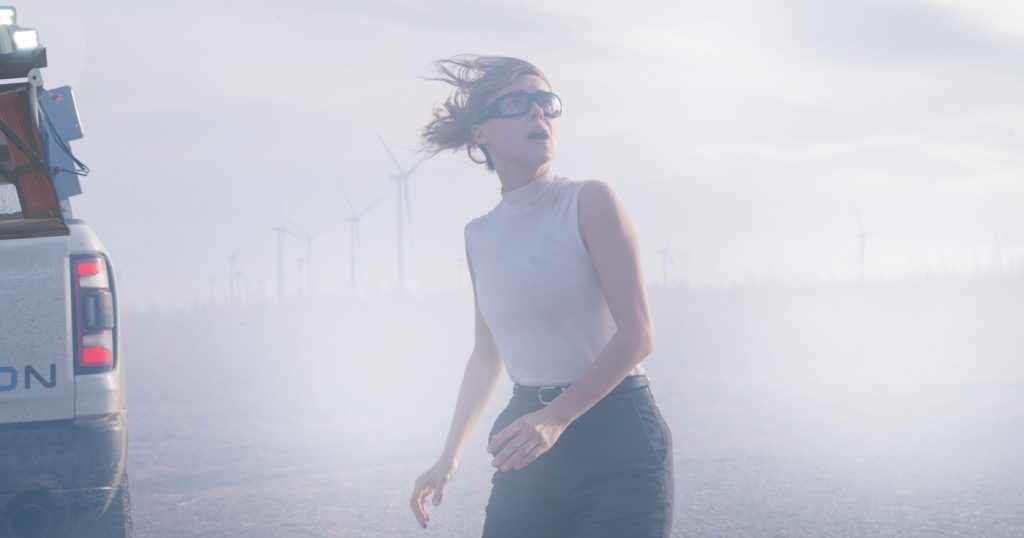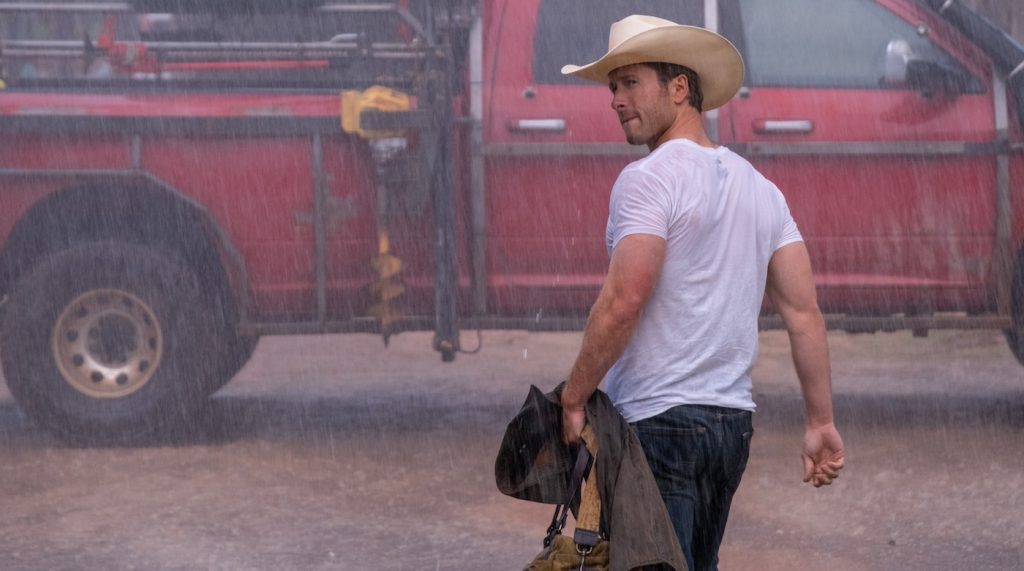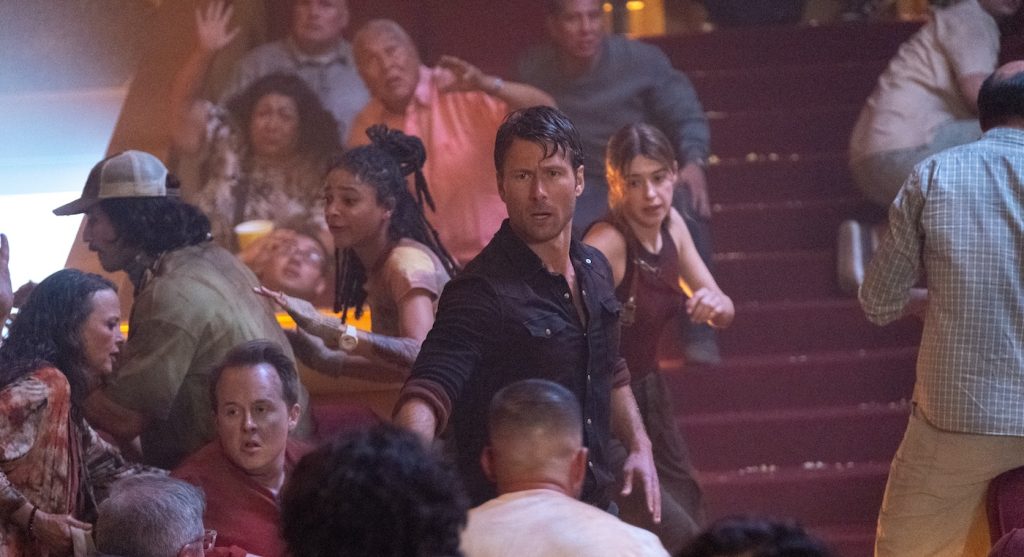“Twisters” Sound Editors on Creating the Ferocious Voice of Six Distinct Tornadoes
Catastrophic weather struck a chord with moviegoers over the weekend when Twisters blew apart box office expectations and raked in a whopping $81 million for its debut. The action spectacle, directed by Lee Isaac Chung (Minari) and filmed in Oklahoma, stars Daisy Edgar-Jones, Glen Powell, and Anthony Ramos as storm chasers determined to study tornadoes by driving right to the edge of wind-torn disaster.
Twisters co-stars six different tornadoes conjured by Industrial Light & Magic’s visual effects and Skywalker Sound staffers, including supervising sound editors Al Nelson and Bjørn Ole Schroeder, previously lauded for their Oscar-winning work on Top Gun: Maverick.
Speaking from Northern California, Nelson and Schroeder recount their first-hand encounters with tropical storms and explain their method for orchestrating Twisters‘ fearsome howls, thumps, and explosions.
Six different tornadoes confront Daisey Edgar-Jones’ Kate, Glen Powell’s Tyler, and Anthony Ramos. How did you capture the sounds and shape the “voice” for each of these tornadoes?
A: I appreciated you terming it that way because it was our intention for each tornado to have a voice and a personality. When we first met with Isaac more than a year ago, he explained that some tornadoes are bigger, and some are smaller. The one in the swimming pool is supposed to be terrifying, but the one in the end is kind of magical. We’re using a lot of the same layers; it’s just a matter of how we lean into them to depict each tornado as a different voice.
In gathering tornado sounds, did you digitally generate audio elements, or is everything analog?
Al: Almost exclusively, everything you hear is organic, whether it’s the pulse from a freight train or low-frequency sounds like helicopters. A horse bellowing might be one thing you would hear. There are some vocalizations in there that are meant to basically sweeten the wind. I also did a bunch of recordings during a tropical storm when I was quarantined in Florida. I cracked open the door, recorded the whipping wind, took that sound, and manipulated it to get these tonalities – –
Wait, sorry to interrupt. You’re saying that during the pandemic you actually…
A: I was on vacation in Florida visiting my folks, and conveniently, this tropical storm came through. When opportunity knocks, you take advantage of it. We got some great wind [sounds] that way.
You just happened to have the right recording equipment?
A: Oh yeah, everywhere I go, I bring recording gear.
Bjorn: [laughing] Yeah.
Al: And in our research, we spoke to people who often describe a tornado as being kind of like a freight train. And then there are variations, such as the howl, the pulse, and the whipping winds, and we added in our debris. I did use some sonic tricks. I’d run sounds through an LFO [Low-Frequency Oscillator] filter, which gave us this pulsing sound. All these very specific layers allowed us to orchestrate each tornado — sometimes more pulse, sometimes more howl, sometimes more debris — depending on what the story needed.
Bjorn: And I have to say Devendra Cleary, our main unit sound recordist, did a fantastic job. When you see the actors’ faces being blown back by the wind, like when Kate can barely open the truck door open, that’s not her acting — there’s this huge fan blasting her with wind. Most of what you hear in the film is production audio captured on set. You feel drawn to the emotions because Isaac had our actors in vehicles — there’s a person on top driving the actors around — but there’s another vehicle in front of them blasting air, blasting debris, throwing stuff at them. Our actors weren’t just in a truck with a blue screen behind them pretending there was a tornado. Then, our team at Skywalker was able to clean up the dialogue, so all that interaction you hear is coming from the set. It’s not ADR [Automated Dialogue Replacement], where the actors re-do their dialogue on a cozy, quiet stage.

Sometimes, spectacle can overwhelm the characters in big action movies. In this case, it seems like you designed quiet moments that give the characters room to breathe.
Al: The tornado takes up so much bandwidth, but if you’re just loud all the time, you push your audience away. Working with our mixers Pete Horner and Chris Boyes, we found places to “reset.”

SPOILER ALERT
The movie builds toward a huge sequence in which a tornado rips through a movie theater, and all hell breaks loose. Could you break down that scene in terms of the audio elements?
Al: There’s so much happening — rain, hail, there’s a truck, a refinery exploding, people screaming and shouting.
Bjorn: An old-fashioned movie playing!
Al: Add to that the trolley car, and on top of that, there’s an EF-5 tornado moving at 200 miles an hour. They’d created such a convincing visual landscape for this tornado; what we tried to do, in combination with the actors, was to tell this story sonically. First, we put together all of the sounds we would need. “This is the sound for the tornado, this is the wind, this is debris, here are the vocals, here’s the truck.” Then what we do editorially is [tell the audience], “Pay attention to this.” We hear Kate’s footsteps, we hear Kate breathing, and there is not a lot of debris or wind as she runs to the truck and opens the door. Then, as she’s driving, Kate gets pelted by rain and hail, but we’ve removed that, and it’s mostly debris hits. Then Kate rides up to the oil refinery, everything stops, the music stops, and you hear the explosion. Then Kate keeps cruising forward, slams on the brake, drills [the truck] into the ground, releases the [sodium] polyacrylate into the tornado, we hear the tornado throb and thump, we cut back to the movie theater, the screen rips open and all we hear is the howl of the wind, and then we’re paying attention to the actors. In the same you’d orchestrate music, it’s like our mixers are dancing, Pete’s saying I’ve got a melody here we’ve got to push. Where’s Kate? Cut to the tornado throb – now let’s go into the cloud, cut to Tyler, more throb, less rain, more hail, less throb; now we need to hear the rip of the screen. Isaac’s telling us, “Oh no, now they’re really done for, there’s a big hole in the theater!” Very specific moments. What we’re doing is telling you, the viewer, what to pay attention to because if you hear rain, wind, music, and everything all at once, you will be overwhelmed. We decide what to put in the speaker to tell you the story.

You guys started working on Twisters in spring of 2023 and finished a couple of months ago. What’s been your takeaway from this experience?
Bjorn: Al and I have been fortunate to work on great projects like Top Gun, and there are similarities here in that Twisters is also a throwback to this type of wonderfully grounded tentpole action film. The science Kate comes up with is experimental but it could be real. Twisters has a basis in reality and that’s what Isaac wanted. He wanted to make something that wasn’t fantastical. He wanted to make something real.
For more on Twisters, check out these stories:
“Twisters” Editor Terilyn A. Shropshire on Whipping Up a Winning Cut
The Real Life Relief Efforts “Twisters” is Supporting
Featured image: (from left) Tyler (Glen Powell) and Kate (Daisy Edgar-Jones) in Twisters, directed by Lee Isaac Chung.



